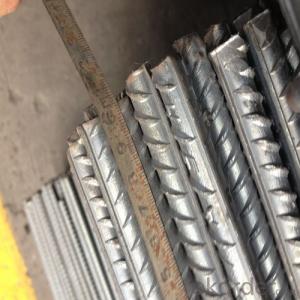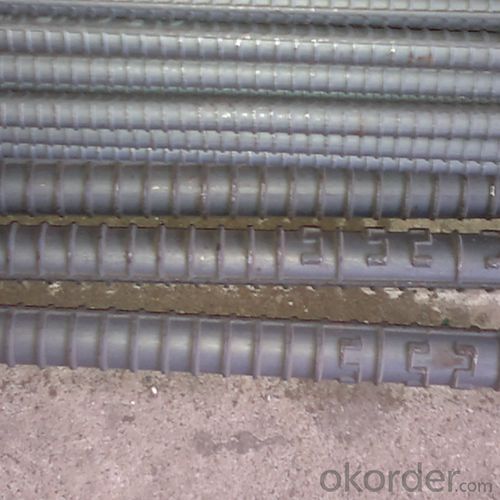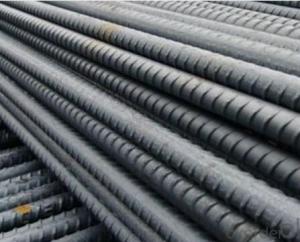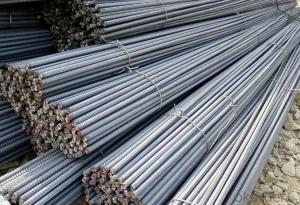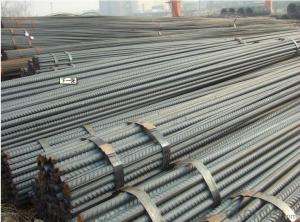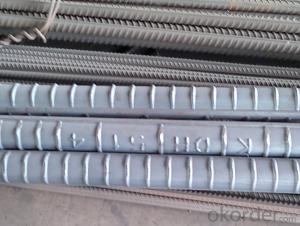Deformed Steel Bar HRB4000 HRB500 ASTM A615 GR40/GR60
- Loading Port:
- Tianjin
- Payment Terms:
- TT or LC
- Min Order Qty:
- 100 m.t.
- Supply Capability:
- 40000 m.t./month
OKorder Service Pledge
OKorder Financial Service
You Might Also Like
Product Description:
OKorder is offering Deformed Steel Bar HRB4000 HRB500 ASTM A615 GR40/GR60 at great prices with worldwide shipping. Our supplier is a world-class manufacturer of steel, with our products utilized the world over. OKorder annually supplies products to European, North American and Asian markets. We provide quotations within 24 hours of receiving an inquiry and guarantee competitive prices.
Product Applications:
Deformed Steel Bar HRB4000 HRB500 ASTM A615 GR40/GR60 are ideal for structural applications and are widely used in the construction of buildings and bridges, and the manufacturing, petrochemical, and transportation industries.
Product Advantages:
OKorder's Deformed Steel Bar HRB4000 HRB500 ASTM A615 GR40/GR60 are durable, strong, and resist corrosion.
Main Product Features:
· Premium quality
· Prompt delivery & seaworthy packing (30 days after receiving deposit)
· Corrosion resistance
· Can be recycled and reused
· Mill test certification
· Professional Service
· Competitive pricing
Product Specifications:
Standard | GB | HRB400 | |
Diameter | 6mm,8mm,10mm,12mm,14mm,16mm,18mm,20mm, 22mm,25mm,28mm,32mm,36mm,40mm,50mm | ||
Length | 6M, 9M,12M or as required | ||
Place of origin | Hebei, China mainland | ||
Advantages | exact size, regular package, chemical and mechanical properties are stable. | ||
Type | Hot rolled deformed steel bar | ||
Brand name | DRAGON | ||
Chemical Composition: (Please kindly find our chemistry of our material based on HRB500 as below for your information)
Grade | Technical data of the original chemical composition (%) | ||||||
C | Mn | Si | S | P | V | ||
HRB400 | ≤0.25 | ≤1.60 | ≤0.80 | ≤0.045 | ≤0.045 | 0.04-0.12 | |
Physical capability | |||||||
Yield Strength (N/cm²) | Tensile Strength (N/cm²) | Elongation (%) | |||||
≥400 | ≥570 | ≥14 | |||||
Theoretical weight and section area of each diameter as below for your information:
Diameter(mm) | Section area (mm²) | Mass(kg/m) | Weight of 12m bar(kg) |
6 | 28.27 | 0.222 | 2.664 |
8 | 50.27 | 0.395 | 4.74 |
10 | 78.54 | 0.617 | 7.404 |
12 | 113.1 | 0.888 | 10.656 |
14 | 153.9 | 1.21 | 14.52 |
16 | 201.1 | 1.58 | 18.96 |
18 | 254.5 | 2.00 | 24 |
20 | 314.2 | 2.47 | 29.64 |
22 | 380.1 | 2.98 | 35.76 |
25 | 490.9 | 3.85 | 46.2 |
28 | 615.8 | 4.83 | 57.96 |
32 | 804.2 | 6.31 | 75.72 |
36 | 1018 | 7.99 | 98.88 |
40 | 1257 | 9.87 | 118.44 |
50 | 1964 | 15.42 | 185.04 |
Usage and Applications of HRB400 Deformed Steel Bar:
Deformed bar is widely used in buildings, bridges, roads and other engineering construction. Big to highways, railways, bridges, culverts, tunnels, public facilities such as flood control, dam, small to housing construction, beam, column, wall and the foundation of the plate, deformed bar is an integral structure material. With the development of world economy and the vigorous development of infrastructure construction, real estate, the demand for deformed bar will be larger and larger..
Packaging & Delivery of HRB400 Deformed Steel Bar:
Packaging Detail: products are packed in bundle and then shipped by container or bulk vessel, deformed bar is usually naked strapping delivery, when storing, please pay attention to moisture proof. The performance of rust will produce adverse effect.
Each bundle weight: 2-3MT, or as required
Payment term: TT or L/C
Delivery Detail: within 45 days after received advanced payment or LC.
Label: to be specified by customer, generally, each bundle has 1-2 labels
Trade terms: FOB, CFR, CIF
FAQ:
Q1: Why buy Materials & Equipment from OKorder.com?
A1: All products offered byOKorder.com are carefully selected from China's most reliable manufacturing enterprises. Through its ISO certifications, OKorder.com adheres to the highest standards and a commitment to supply chain safety and customer satisfaction.
Q2: How do we guarantee the quality of our products?
A2: We have established an advanced quality management system which conducts strict quality tests at every step, from raw materials to the final product. At the same time, we provide extensive follow-up service assurances as required.
Q3: How soon can we receive the product after purchase?
A3: Within three days of placing an order, we will begin production. The specific shipping date is dependent upon international and government factors, but is typically 7 to 10 workdays.
Q4: What makes stainless steel stainless?
A4: Stainless steel must contain at least 10.5 % chromium. It is this element that reacts with the oxygen in the air to form a complex chrome-oxide surface layer that is invisible but strong enough to prevent further oxygen from "staining" (rusting) the surface. Higher levels of chromium and the addition of other alloying elements such as nickel and molybdenum enhance this surface layer and improve the corrosion resistance of the stainless material.
Q5: Can stainless steel rust?
A5: Stainless does not "rust" as you think of regular steel rusting with a red oxide on the surface that flakes off. If you see red rust it is probably due to some iron particles that have contaminated the surface of the stainless steel and it is these iron particles that are rusting. Look at the source of the rusting and see if you can remove it from the surface.
Images:
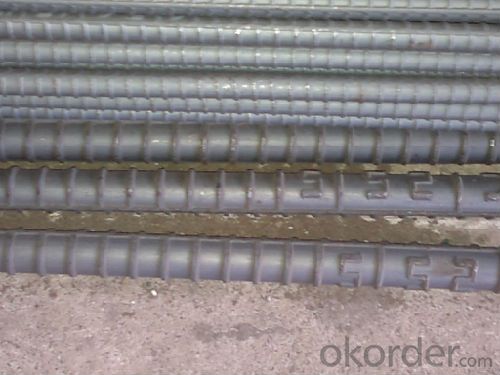
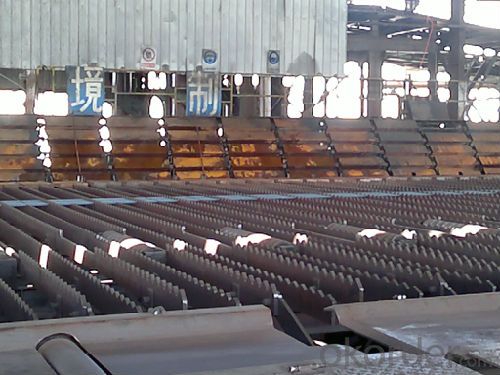
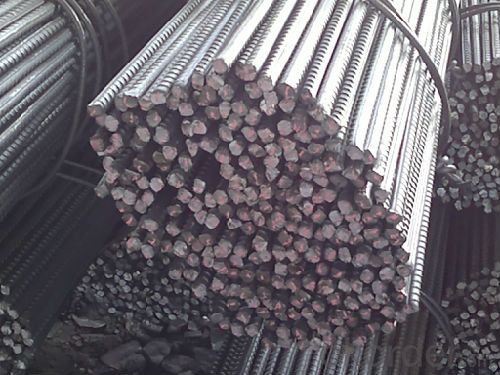
- Q: How do steel rebars affect the fire resistance of concrete structures?
- Steel rebars can significantly enhance the fire resistance of concrete structures. The presence of steel rebars in concrete acts as reinforcement, providing added strength and stability to the structure. This reinforcement helps the concrete withstand the intense heat generated during a fire. The fire resistance of concrete structures is primarily due to the low thermal conductivity of concrete. When exposed to high temperatures, concrete undergoes a process called spalling, where the outer layer of the concrete breaks off due to the rapid expansion of water trapped within. However, the presence of steel rebars helps minimize spalling by holding the concrete together, preventing it from falling apart. Furthermore, steel rebars have a higher melting point compared to concrete. This means that even when exposed to extreme heat, the steel rebars retain their strength and integrity. As a result, the overall structural stability of the concrete structure is maintained, even under fire conditions. Steel rebars also act as a heat sink, absorbing and dissipating heat away from the surrounding concrete. This heat dissipation prevents localized hotspots from forming and spreading throughout the structure, minimizing the risk of structural failure. To improve the fire resistance of concrete structures further, special types of steel rebars, known as fire-resistant or fire-rated rebars, can be used. These rebars are specifically designed to withstand high temperatures for extended periods without losing their strength. They are often coated with materials such as epoxy or intumescent coatings that provide additional protection against fire. In conclusion, steel rebars play a crucial role in enhancing the fire resistance of concrete structures. Their presence improves the overall structural stability, minimizes spalling, dissipates heat, and provides added strength to withstand the intense heat generated during a fire.
- Q: Can steel rebars be used in cold weather concreting?
- Yes, steel rebars can be used in cold weather concreting. However, it is important to take necessary precautions and follow guidelines to ensure the rebars remain free from corrosion in low temperatures. Additionally, using proper construction techniques and allowing sufficient time for curing can help prevent any negative effects on the concrete due to cold weather conditions.
- Q: What are the common sizes of steel rebars?
- The common sizes of steel rebars vary, but some commonly used sizes include #3 (3/8-inch diameter), #4 (1/2-inch diameter), #5 (5/8-inch diameter), #6 (3/4-inch diameter), and #8 (1-inch diameter).
- Q: Can steel rebars be used in road or highway construction?
- Yes, steel rebars can be used in road or highway construction. Steel rebars, also known as reinforcing bars, are commonly used in the construction industry to provide additional strength and support to concrete structures. In road and highway construction, rebars are typically used in the construction of reinforced concrete pavements, bridge decks, and retaining walls. Rebars are embedded in concrete to enhance its tensile strength, as concrete is strong in compression but weak in tension. By adding rebars to the concrete, it helps distribute the tensile forces and improves the overall durability and load-bearing capacity of the road or highway infrastructure. The use of steel rebars in road or highway construction offers several advantages. Firstly, it improves the structural integrity and longevity of the infrastructure, as reinforced concrete structures are better able to withstand heavy traffic loads, temperature changes, and environmental factors. Secondly, rebars help prevent cracking and deterioration of the concrete, reducing the need for frequent repairs and maintenance. Additionally, the use of rebars allows for more efficient and cost-effective construction, as it enables the use of thinner concrete sections without compromising strength. Overall, steel rebars are a crucial component in road or highway construction, as they provide the necessary reinforcement to ensure the strength, durability, and longevity of the infrastructure.
- Q: How do steel rebars prevent corrosion in concrete structures?
- Steel rebars prevent corrosion in concrete structures through the process of passivation. Passivation is the formation of a thin, protective oxide layer on the surface of the steel rebar, which acts as a barrier against corrosion-causing agents. When steel rebars are embedded in concrete, the alkaline environment created by the cement paste helps in passivating the steel. The high pH level of the concrete creates a protective layer of iron oxide (rust) on the rebar's surface, preventing the steel from coming into contact with moisture and oxygen. Furthermore, the dense and impermeable nature of well-constructed concrete limits the movement of water and other corrosive substances towards the steel rebars. This reduces the likelihood of corrosion initiation and its progression. In addition to the alkaline environment and concrete's impermeability, steel rebars are also typically coated with a layer of epoxy or zinc to provide an extra layer of protection. These coatings further enhance the resistance of the steel to corrosion, particularly in aggressive environments such as marine or chloride-rich conditions. Regular maintenance and preventive measures, such as ensuring proper concrete cover over the rebars and avoiding the presence of excessive moisture or chloride ions, also play a crucial role in preventing corrosion in concrete structures.
- Q: What is the role of steel rebars in beam and column design?
- Steel rebars play a crucial role in beam and column design as they provide reinforcement and enhance the structural integrity of these elements. In reinforced concrete structures, rebars are used to resist tensile forces that concrete alone cannot withstand. In beams, rebars are typically placed at the bottom to counteract tensile stresses caused by bending moments. By distributing the load across the beam's length, rebars effectively increase its strength and prevent cracking or failure. The rebars' ability to resist tension helps the beam maintain its shape and load-bearing capacity, ensuring the structural stability of the entire construction. Similarly, in columns, rebars are placed throughout the length to resist both axial and bending forces. They improve the column's ability to withstand compression while also providing additional resistance against lateral loads from seismic or wind forces. The presence of rebars in columns significantly enhances their load-bearing capacity and overall stability. In summary, steel rebars play a critical role in beam and column design by providing reinforcement against tensile forces, increasing structural strength, preventing cracking, and ensuring the overall stability and safety of the structure.
- Q: How do steel rebars resist buckling in concrete structures?
- Steel rebars resist buckling in concrete structures due to their high tensile strength and ability to distribute and transfer loads. When concrete is subjected to compressive forces, the rebars provide tensile strength to counteract these forces. The ribbed surface of rebars enhances their bond with the surrounding concrete, ensuring effective load transfer. This reinforcement prevents the concrete from buckling under compressive stress, thereby enhancing the overall stability and strength of the structure.
- Q: What are the guidelines for ensuring proper concrete cover over steel rebars?
- The guidelines for ensuring proper concrete cover over steel rebars include: 1. Following the specified cover requirements mentioned in the structural design or building codes. 2. Ensuring that the rebars are placed at the correct depth within the concrete to achieve the desired cover. 3. Using appropriate spacers or chairs to maintain the required distance between the rebars and the formwork during concrete pouring. 4. Ensuring proper consolidation of the concrete to eliminate voids or air pockets around the rebars. 5. Regularly inspecting the concrete cover during construction and taking necessary measures to correct any deficiencies. 6. Protecting the rebars from corrosion by using high-quality concrete with appropriate additives and ensuring proper curing of the concrete. 7. Regular maintenance and inspection of the structure throughout its lifespan to ensure the concrete cover remains intact and provides adequate protection to the rebars.
- Q: How do steel rebars affect the overall crack resistance of concrete structures?
- Steel rebars significantly improve the crack resistance of concrete structures. By reinforcing the concrete, rebars help distribute and absorb tensile forces, preventing the formation and propagation of cracks. This reinforcement enhances the overall strength and durability of the concrete, making the structure more resistant to cracking under various loads and environmental conditions.
- Q: What are the guidelines for repairing or replacing corroded steel rebars in existing structures?
- The severity of corrosion and project-specific requirements determine the guidelines for repairing or replacing corroded steel rebars in existing structures. However, there are some general guidelines that can be followed: 1. Before proceeding with any repairs or replacements, conduct a thorough assessment of the corrosion damage. This may involve visual inspections, non-destructive testing, or laboratory analysis of samples taken from the rebars. 2. Always prioritize safety when working with corroded rebars. Take adequate precautions to ensure the safety of workers and surrounding areas. This may include using personal protective equipment and creating a stable work environment. 3. Determine the extent of corrosion and its impact on the structural integrity of the rebars. This will help determine whether repair or replacement is necessary. 4. Use various repair methods depending on the severity of corrosion. These methods may include removing the corroded portion of the rebar and applying a corrosion inhibitor or protective coating. Electrochemical techniques such as cathodic protection can also be used to prevent further corrosion. 5. If repair is not feasible due to extensive corrosion damage, consider replacing the corroded rebars. The replacement rebars should be of the same or higher grade and properly anchored to maintain the structural integrity of the existing structure. 6. Consider the design requirements of the structure when repairing or replacing corroded rebars. The repaired or replaced rebars should meet the necessary load-bearing capacity and be properly integrated into the existing structure. 7. Implement rigorous quality control measures throughout the repair or replacement process to ensure the effectiveness and durability of the repairs. This may include regular inspections, testing, and monitoring of the repaired or replaced rebars. It is important to note that these guidelines are general recommendations and should be customized to the specific circumstances and requirements of each project. Therefore, it is advisable to consult with a structural engineer or a professional experienced in repairing corroded steel rebars for a more accurate and detailed guideline.
Send your message to us
Deformed Steel Bar HRB4000 HRB500 ASTM A615 GR40/GR60
- Loading Port:
- Tianjin
- Payment Terms:
- TT or LC
- Min Order Qty:
- 100 m.t.
- Supply Capability:
- 40000 m.t./month
OKorder Service Pledge
OKorder Financial Service
Similar products
Hot products
Hot Searches
Related keywords
